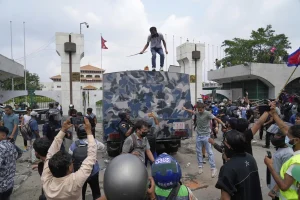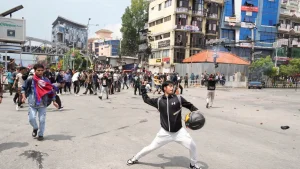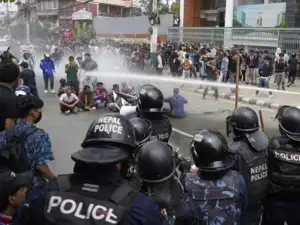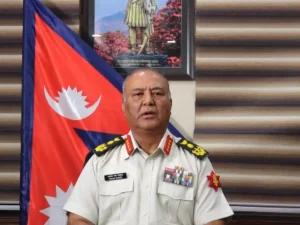Kathmandu, Nepal – The Nepal protests have escalated into a full-scale political crisis, forcing the Nepal Army to assume control of security operations across the country. The unprecedented Gen Z-led uprising has resulted in 30 deaths and over 1,000 injuries, according to Nepal’s health ministry, making these Nepal protests among the deadliest in the nation’s recent history. Emergency services have been mobilized nationwide to handle the massive influx of patients as hospitals remain on high alert.
Nepal Army Chief Ashok Raj Sigdel has taken direct command of the security situation, meeting with Gen Z protest representatives and conducting consultations with related stakeholders. The Nepal protests have fundamentally altered the country’s political landscape, with curfew orders remaining in force and expected to continue as authorities struggle to restore order.
Prime Minister KP Sharma Oli Forced to Resign

The Nepal protests achieved their primary objective when mounting pressure forced Prime Minister KP Sharma Oli to resign from office. Oli’s resignation represents a significant victory for the Gen Z movement that organized these massive demonstrations across Nepal. The former Prime Minister had previously alleged that “infiltration by various vested interest groups” was responsible for the violence during the Nepal protests.
Before his resignation, Oli announced plans to establish a panel to investigate the protests and provide financial relief to victims, along with free medical treatment for those injured during the Nepal protests. However, these concessions proved insufficient to quell the growing movement demanding his removal from power.
Social Media Ban Triggers Nationwide Uprising


The Nepal protests originated from the government’s controversial decision to ban 26 social media platforms, including WhatsApp, Instagram, and YouTube. This heavy-handed censorship attempt sparked immediate outrage among Nepal’s tech-savvy Gen Z population, who viewed the ban as an assault on their fundamental rights to communication and expression.
Although the government later revoked the social media ban, the damage was already done. The Nepal protests had gained unstoppable momentum, with demonstrators demanding not just the restoration of social media access but also broader political reforms and accountability from Nepal’s leadership.
Tribhuvan International Airport Reopens After Suspension
Kathmandu’s Tribhuvan International Airport resumed flight operations at 6 PM Wednesday after being completely shut down during the height of the Nepal protests. The Nepal Civil Aviation Authority issued strict guidelines for passengers, requiring them to contact airline companies for flight information and carry official tickets and identification documents when traveling to the airport.
The airport closure during the Nepal protests demonstrated the severity of the situation, as authorities prioritized security over economic activity. The reopening signals a gradual attempt to restore normalcy, though the underlying political crisis remains unresolved.
Widespread Violence and Property Destruction


The Nepal protests witnessed unprecedented violence, with demonstrators torching residences of former Prime Ministers, former home ministers, and several other top political leaders. Government buildings, including the Parliament and Supreme Court, suffered severe damage during the Gen Z protesters’ aggressive campaign against the established political order.
Visuals from Kathmandu showed Army personnel patrolling the capital while smoke continued billowing from a Nepali media channel’s headquarters, highlighting the extensive property damage caused during the Nepal protests. The destruction of media facilities particularly underscored the protesters’ anger over perceived censorship and information control.
Army Intensifies Security Operations


The Nepal Army has intensified its crackdown on looting and jail breaks that occurred during the Nepal protests. Four individuals involved in looting were detained in Maharajgunj, while security forces reported that suspicious individuals abandoned stolen cash and weapons when confronted by military personnel.
Army Chief Sigdel appealed for dialogue with protesters, stating the need to “normalise the present difficult situation and protect our historical and national heritage and public as well as private property.” The military’s involvement in the Nepal protests represents an extraordinary measure reflecting the government’s inability to maintain civilian control.
International Concerns and Advisory Warnings
The Nepal protests have attracted significant international attention, with multiple countries expressing concern over the deteriorating situation. Prime Minister Narendra Modi described the violence as “heart-wrenching” and called for peace, emphasizing Nepal’s importance for India’s security interests. Modi chaired a Cabinet Committee on Security meeting to discuss the ongoing developments.
Russia expressed concern over the Nepal protests and advised its citizens against traveling to Nepal while closely monitoring the situation. Israel’s foreign ministry issued similar travel advisories, warning Israeli citizens against visiting Nepal and instructing those already in the country to remain indoors and avoid crowds.
Army Appeals for Public Cooperation


The Nepal Army has made public appeals for cooperation in maintaining peace and security while expressing condolences for lives lost during the Nepal protests. Military leadership emphasized that curfew orders will remain in place until further notice, indicating that the security situation remains precarious despite the airport reopening and gradual restoration of some services.
Path Forward and National Reconciliation
The Nepal protests have fundamentally transformed Nepal’s political landscape, creating opportunities for new leadership while highlighting deep-seated grievances among the country’s youth. The Gen Z movement’s success in forcing governmental change demonstrates the power of organized digital activism, even when facing state censorship and military intervention.
As Nepal moves forward from these historic Nepal protests, the challenge will be translating street victories into sustainable political reforms that address the underlying issues of governance, corruption, and youth representation that sparked this unprecedented uprising.

